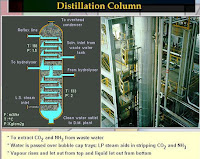For separation and purification of chemical compounds, the most commonly used equipment is distillation column. Which have its application in every petrochemical and refining industry along with food and pharmaceutical industries, it is an option for separation by the creation of phase in the mixture of chemical compounds, it is employed anywhere when there is a necessity of separation or purification operations. If it doesn’t work during the designing than other unit operation are chosen for desired separations.
Designing a distillation column is the most important skill of a chemical engineer because it covers all the concepts of the course. For graduates who are at their project work and plant personals who want to learn from basis or just want a simple rough procedure which is used as thumb rule by experiences from the industrial personal, they can follow the below procedure for their startup.
Initial we must make a lot of discussion before design because to avoid the confusion and clear the layers of concepts which overlap on each other, which helps to find out the relation of each concept. For any design their will a “basis, skeleton structure, balancing, mathematical model, analysis, pilot plant trail, modifying, reanalysis, optimize” and the final design come out from the drawing board, right now we stick with the column design only we study about the mechanical designing part later.
Let start for a binary distillation column:Designing a distillation column is the most important skill of a chemical engineer because it covers all the concepts of the course. For graduates who are at their project work and plant personals who want to learn from basis or just want a simple rough procedure which is used as thumb rule by experiences from the industrial personal, they can follow the below procedure for their startup.
Initial we must make a lot of discussion before design because to avoid the confusion and clear the layers of concepts which overlap on each other, which helps to find out the relation of each concept. For any design their will a “basis, skeleton structure, balancing, mathematical model, analysis, pilot plant trail, modifying, reanalysis, optimize” and the final design come out from the drawing board, right now we stick with the column design only we study about the mechanical designing part later.
This means that two components solution is selected as feed mixture to the distillation column no other impurities or trace will exist. Now we should gather all the data required which are
- The heat of vaporization at normal boiling point
- Data on Heat capacities
- Data of Vapor pressure
- Vapour and liquid equilibrium data of the selected compounds
Equations and calculation which are required are:
- Antoine equation
- Fenske equation
- Stage equation
- Dew points and bubble points
- Equilibrium flash calculations
- Q-line calculation
- Design methods
- McCabe-Thiele method (Graphical method)
- Low product concentrations
- The Smoker equations
- Plate efficiency
- Prediction of plate efficiency
- O'Connell's correlation
- Van Winkle's correlation
- AIChE method
- Entrainment
1. Analytical Method: which is known by Sorel-Lewis method and involves plate to plate calculations involving material and energy balance equations.
2. Graphical Method:
i) Based on equilibrium relation and material balance we use Mc-Cabe-Thiele method.
ii) Based on equilibrium relation and energy balance we use Ponchon-Savarit method.
Column sizing:
- Selection of plate type in a distillation column
- Plate material of construction
- Plate and inner column flow path hydraulic design
Plate-design procedure
- Plate occupying areas calculation
- The diameter of the column and degree of narrowing
- Liquid-flow arrangement up and bottom of the tray
- Entrainment cause and prevention parameters
- Weep point calculation by optimizing
- Weir liquid crest designing from the standard data
- Weir dimensions which depend on the plate diameter and liquid flow rate
- Perforated area of the tray which help in contact with the liquid and vapour
- Hole size on the sieve tray which determines the area of opening for liquid and vapour to flow
- Hole pitch which depends on the distance between the centres of the hole and provides enough gaps
- Hydraulic gradient which makes the liquid flow from top to bottom of the column and passes from weir to plates
- Plate pressure drop caused by the liquid which flows over from plate to plate
- Downcomer design [back-up] where liquid flow from sides of the column and liquid hold up for continuous flow
- Cooling water quantity required at top of the column for condensing the vapours
- Condenser duty which depends on the quantity of vapour produced
- Reboiler steam consumption which adds the driving force of temperature gradient to the mixture present in the column
 |
| Distillation column used for separation of NH3 and CO2 from wastewater |
By using this calculator you can calculate how many theoretical stages are required to separate a binary mixture, this calculator uses Fenske, Underwoods and Gilland Correlation as above said along with the famous McCabe-Thiele method.
All above are some of the basic topics which are to be covered and must be known for designing a distillation column.
Literature which can help to understand
Distillation calculations and formulas Distillation control design